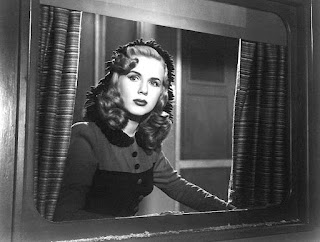I've written a couple of posts on this blog about classic movie character actors or supporting players. Whatever you choose to call them, they help form the foundation of a solid classic film. Where would Rebecca be without Florence Bates, Nigel Bruce or the terrific Gladys Cooper? How about Lost Horizon without Isabel Jewel or Thomas Mitchell? These actors and actresses add a certain nuance with their characterizations that give zing where there might not be any and act as a foil for the main stars of a movie. Here are a few excellent examples of these tried and true who made their mark on the silver screen.
Eve Arden
"Personally, Veda's convinced me that alligators have the right idea. They eat their young." That quote from 1945's Mildred Pierce is a great example of the kind of lines tossed off so easily and deliciously by Eve Arden (pictured above), who spoke it and others just as biting in Pierce and several dozen more classic movies. Glamorous and chic, Arden was eternally the best friend of the star or the personal assistant to the main character instead of the lead herself.
Making her film debut in 1929, she took to the stage and then back to movies in the late 30's, breaking through with a supporting role in RKO's Stage Door. From then on the size of her parts increased and her persona as a seasoned career woman, spouting sardonic wit and rarely getting the man blossomed.
Making her film debut in 1929, she took to the stage and then back to movies in the late 30's, breaking through with a supporting role in RKO's Stage Door. From then on the size of her parts increased and her persona as a seasoned career woman, spouting sardonic wit and rarely getting the man blossomed.
Besides Mildred Pierce (for which she was nominated for an Academy Award in the Best Supporting Actress category), she appeared in Cover Girl (1944), The Kid from Brooklyn (1946) and Tea for Two (1950). She found her largest audience on television in the 1950's comedy Our Miss Brooks.
Franklin Pangborn
Flustered, fussy, sometimes prissy, always funny are just some of the descriptives of the characters played by the undeniably entertaining Franklin Pangborn. This native of New Jersey most memorably played sales clerks, department store floor walkers or efficient headwaiters and always added character to any scene he was in.
Like Thelma Ritter, Pangborn got his start on the stage in the first quarter of the 20th Century entering films in the mid 1920's. Coming into his own in the late 30's and thoughout the 40's, his film resume reads like a veritable "Best of" list from the Golden Age of Hollywood. Among the dozens of films in which he appeared some of the best are My Man Godfrey (1936), Mr. Deeds Goes to Town (1936), Sullivan's Travels (1941) and Now, Voyager (1942).
Thelma Ritter
Wise-cracking, working class, world weary characters were Thelma Ritter's specialty. Whenever she was on the screen there was never a dull moment and, though she was lucky to be provided with some of the brightest dialogue written in Hollywood, it was her razor sharp delivery that lingers in the memory.
Ritter made her film debut at the age of 45 in a small but very memorable role as the Christmas shopping weary mother in Miracle on 34th Street (1947). In A Letter to Three Wives (1949), she was again unbilled as tart tongued maid Sadie Duggan, but left her mark so impressively that she was cast as Birdie in All About Eve (1950). For Eve she received her first of six Academy Award nominations, four consecutively. Along with Eve, she was nominated for The Mating Season (1951), With a Song in My Heart (1952), Pickup on South Street (1953), Pillow Talk (1959) and The Birdman of Alcatraz (1962), all in the Best Supporting Actress category.
Developing her acting roots on the stage, Ritter was also on Broadway, winning a Tony Award in 1958 as Best Actress (Musical) for New Girl in Town.




